10 of the Best Coefficient.io Alternatives
Manually organizing large amounts of data, from multiple sources is a frustrating and time-consuming task. Fortunately, the right tools can automate the process, letting you skip the tedious parts and get right into the analysis that matters.
Coefficient is one of the most popular tools on the market for moving data through spreadsheets, and with good reason. It’s easy to set up, easy to learn, and for many teams it’s more than worth the price tag.
But what if it isn’t right for you?
Coefficient.io alternatives: Summary table
| Coefficient.io alternative | Starting price | Integration type | Number of connectors | Best for |
| Unito | $49/month | Two-way, real-time | 60+ | Two-way sync and workflow management |
| Supermetrics | $99/month | One-way | 150+ | Marketing intelligence |
| Coupler.io | $29/month | One-way | 60+ | Custom dashboards |
| Liveflow | Custom | One-way | 4 | Turning spreadsheets into finance reports and dashboards |
| Equals | $29/user/month | One-way | 20 | Technical teams and SQL query capabilities |
| Tableau | $70/user/month | Database-focused | Hundreds | Enterprise analytics |
| Grow | Custom | Varies | 100+ | Business intelligence |
| Fivetran | Free | One-way | 700+ | Data warehousing |
| Funnel.io | Free | One-way | 600+ | Advertising and marketing analytics |
| Rivery | $0.90/credit | Nonlinear | 200+ | Custom data workflows |
What is Coefficient.io?

Coefficient.io connects business systems like HubSpot, Salesforce, GA4, and Facebook Ads to Excel or Google Sheets, syncing data with regular updates. Coefficient’s two-way sync also allows you to update data in those systems right from your spreadsheet. It also allows you to filter data, push notifications to Slack, and more. Coefficient’s free plan allows a single user to sync data from three data sources, which is robust enough for small teams, but paid plans support more users and data sources.
This platform has some powerful benefits for anyone who needs to centralize data in spreadsheets. But limitations like plan-gated connectors, a focus on spreadsheets, and limited transformation capabilities mean Coefficient isn’t always the best option.
Here are some of your alternatives.
The 10 best Coefficient.io alternatives
Unito

Unito is the best Coefficient.io alternative for users who need full data integration that goes beyond spreadsheet automation and reporting. Unito integrations keep your data up to date from either end of its numerous integrations in real-time, empowering even the most advanced workflows.
Say, for instance, that you need to integrate a spreadsheet tool like Google Sheets with a platform like Salesforce for better reporting on your sales process. But you also need data from Salesforce tickets to sync with Jira issues, so software developers can work with full context when address prospect or customer needs. A tool like Coefficient.io can’t do that without using a spreadsheet as an intermediary or even as the main point of reference. With Unito, you can keep data flowing across all three tools so it’s always exactly where you need it.
Here’s why Unito is one of the best Coefficient.io alternatives on the market:
- Real-time two-way sync: While both Coefficient.io and Unito offer two-way integrations, the former only updates your data on an hourly basis. Only Unito updates your data in real-time.
- More destinations for your data: With Coefficient.io, you need to use a spreadsheet as the destination for the data you sync. With Unito, that destination can be any integration.
- Data imports vs. synchronization: Coefficient.io essentially imports data into a spreadsheet, keeping it up-to-date from there. Unito builds true, two-way relationships between work items, which support deeper integrations.
Strengths
- You can set up a Unito flow quickly, without any advanced technical knowledge, setting it apart from many Coefficient.io alternatives. Most Unito users set up their first flow in 12 minutes or less.
- Unito offers enterprise-grade integrations without the associated deployment times. This includes advanced security features that enterprise organizations need.
- Unito offers integrations for a wide variety of tools, including project management apps, spreadsheets, and software development tools.
Want a deeper look at how Coefficient.io and Unito compare? Check out this full breakdown.
Main limitation
Unito has over 60 integrations, which isn’t as many as some other Coefficient.io alternatives.
Customer rating

Supermetrics: Best for marketing data integration
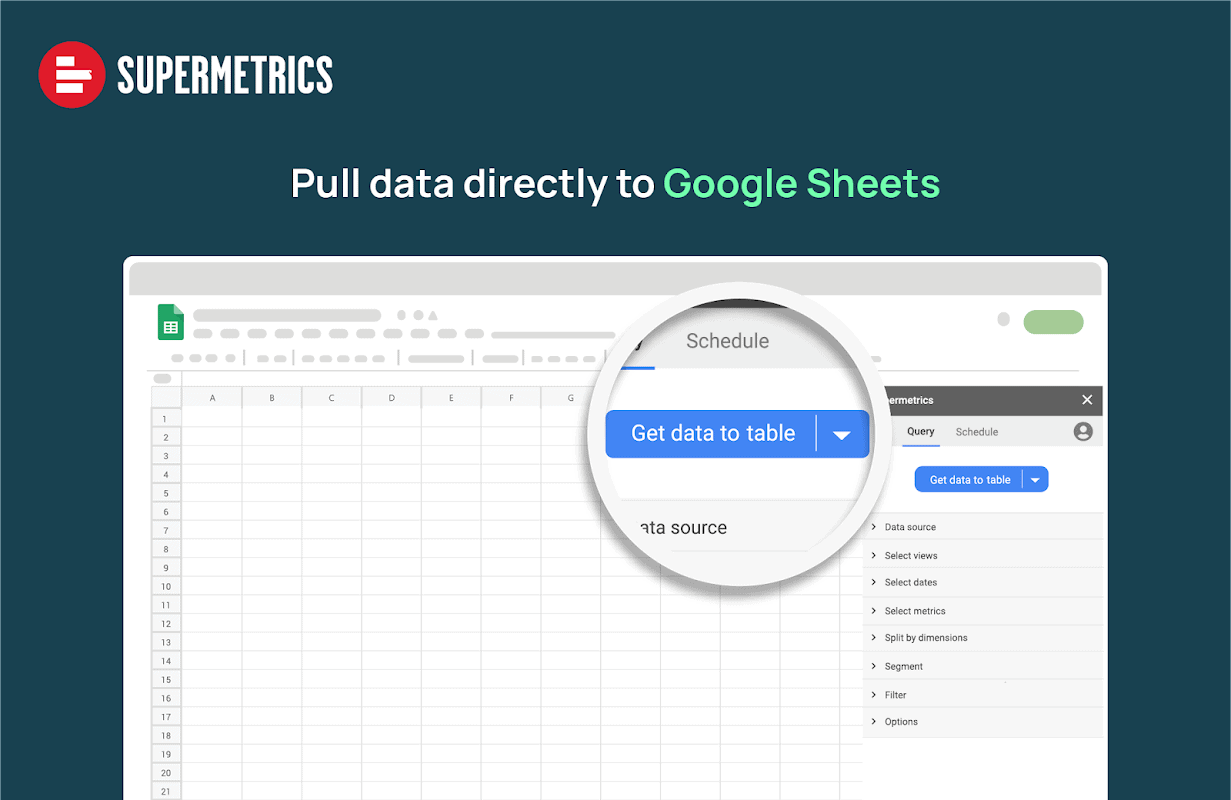
Supermetrics is an integration platform best-suited for marketing teams that need comprehensive consolidation of advertising and marketing data. With over 150 connectors for popular marketing platforms, automated data enrichment, custom-field creation, and more than 60 reporting templates, it’s a strong option for marketers who need to upgrade the way they work.
Strengths
- Deep marketing platform integrations
- Extensive visualization templates
Main limitation
- Marketing focus makes Supermetrics more limited for other use cases
Pricing
Starts at $99 a month.
Coupler.io: Best for custom dashboards
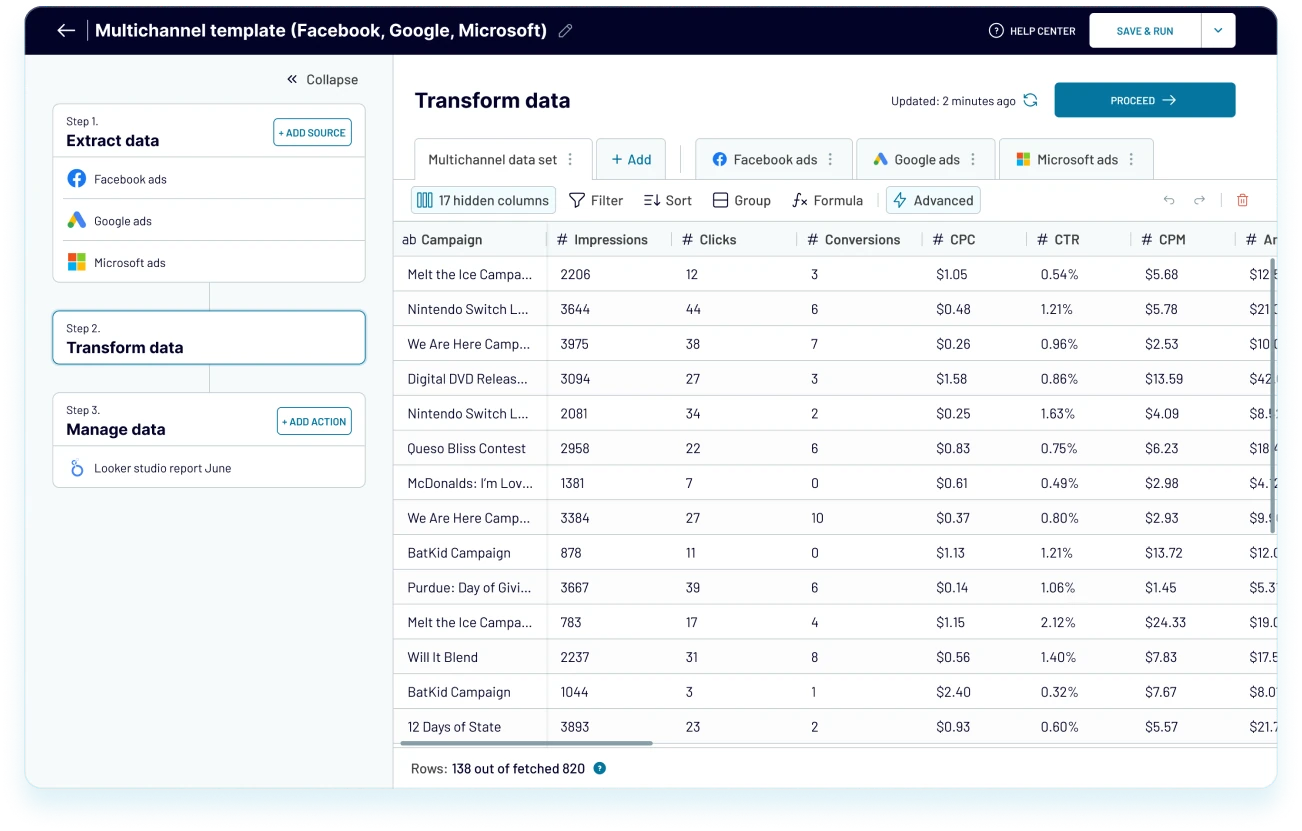
Coupler provides more than just data updates between two systems, they also provide customizable Dashboards for out-of-the-box flexibility. With 60+ connectors and automation options, it’s an appealing option for many teams.
The shortest refresh interval is 15 minutes, which might not be fast enough for some users. It also depends on your data destination for those dashboards instead of its own app, which might not be for everyone.
Strengths
- 60+ supported data sources
- Customizable dashboard templates
- Automated data workflows
- No-code setup
Main limitation
- 15-minute data refresh
Pricing
Free plan available, with paid plans starting at $29 a month.
Liveflow: Best for finance dashboards
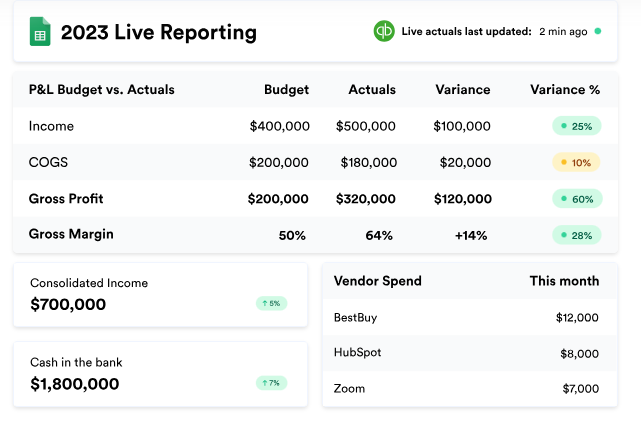
Most of the software on this list is adaptable across numerous use cases, but Liveflow’s biggest strength is also its biggest drawback: a narrow scope. Liveflow is focused only on connecting QuickBooks to either Google Sheets or Excel in real-time. From there it streamlines reporting, consolidation, and budgeting. It also provides customizable templates and live dashboards that let you keep anyone who needs to know in the loop.
This narrow focus means that Liveflow can dramatically expand your capabilities with QuickBooks without any extraneous features. It’s a lean design, and an excellent option if most of your work happens in QuickBooks. Unfortunately, it doesn’t offer much outside that niche.
Strengths
- Real-time sync from QuickBooks and Xero to Google Sheets and Excel
- Financial reporting templates
- Budget consolidation tools
- Live dashboards for stakeholder updates
- Automated reconciliation
Main limitation
- Narrow use case focus and limited integrations
Pricing
Custom pricing.
Equals: Best for technical teams

Equals has a deep feature set that works for technical and non-technical users alike. It lets users query with SQL or with a no-code query-builder. These queries can include more than one source. The sheet itself uses Excel-based formulas and shortcuts most users are already familiar with. Other than templates and dashboards Equals has integrated AI that creates automated summaries, explains formulas, helps with troubleshooting, and streamlines data visualizations and dashboards. Despite only offering 20 connectors, Equals offers an enviable feature set, provided your data sources are supported.
Strengths
- SQL querying and no-code query builder
- Multi-source query support
- AI assistance
- Excel-based formulas and shortcuts
- 20 data source connectors
Main limitation
- Smaller connector library compared to Coefficient’s.
Pricing
Free plan available, with paid plans starting at $29 per user per month.
Tableau: Best for enterprise analytics

Tableau is a comprehensive, end-to-end data platform from Salesforce, and as such includes all the templates, analysis, and dashboards you would expect. Two AI features make this Coefficient alternative stand out. First is “Einsten,” the AI copilot that streamlines productivity across all your reporting tasks. Second is Tableau Pulse, which automatically and contextually highlights key data, and proactively guides newer users.
While having possibly the biggest and most powerful analytics suite on this list, Tableau’s pricing is surprisingly accessible. Its per-user pricing can be expensive for larger organizations, while its focus on database integrations could be a pro or a con, depending on your use case.
Strengths
- Powerful analytics suite
- AI-driven insights
- Extensive database integration support
- Enterprise-grade data integration
Main limitation
- Expensive for larger teams and complex to set up.
Pricing
Starts at $70 per user per month.
Grow: Best for all-in-one business intelligence
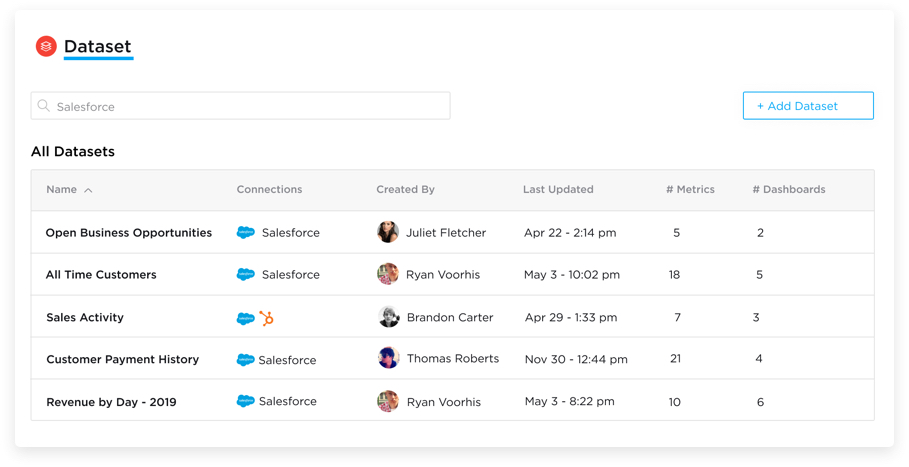
Grow is a business intelligence tool with an excellent selection of data sources. Grow skips the destination and operates as the data-analysis platform with dashboards and analytics built in, making this a very appealing one-stop software for all kinds of data tasks across multiple departments. A built-in sandbox allows users to build and test custom dashboards before deploying them. Sharing analysis and results is facilitated by conventional links, emails, slack, for-TV dashboards, and good old exports.
If you’re already using software for dashboards and analytics, and only looking for integration or consolidation of your data sources, Grow isn’t the best bet for you.
Strengths
- Eliminates the need for separate business intelligence tools
- Comprehensive analytics
- Large library of supported data sources
Main limitation
- Overlaps with existing business intelligence tools, and can be excessive for pure data integration needs.
Pricing
Custom pricing.
Fivetran: Best for data warehousing
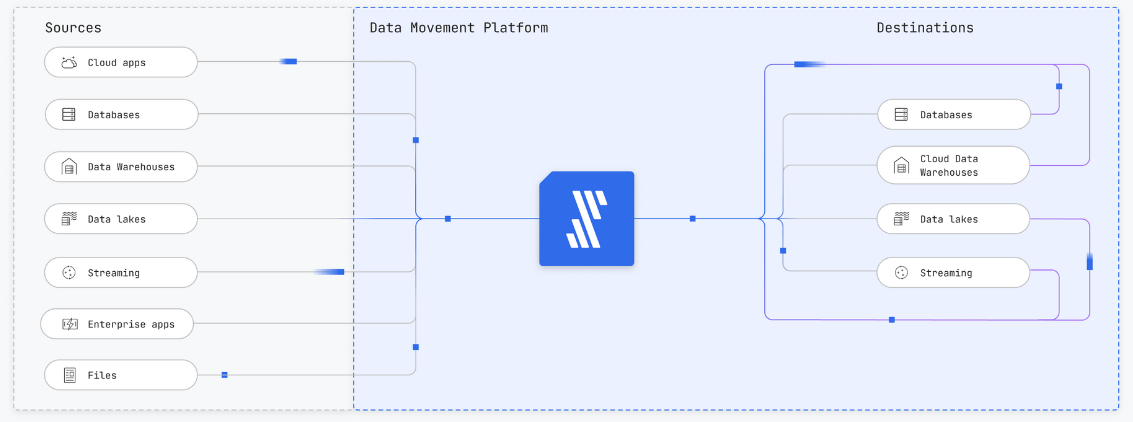
Fivetran is a data movement and transformation platform with a focus on security and versatility. With its 400+ supported data sources, there’s a good chance it will support your use case. Detailed security and governance are big selling points here, making this the best choice for sensitive data.
Pricing is charged per gigabyte of data transferred, though you can use it for free for up to 500,000 monthly synced rows. Not having built-in analytics may be a downside, but for secure data transportation and preparation, Fivetran is a compelling tool.
Strengths
- 400+ supported connectors
- Enterprise-grade security and governance
- Automated schema management
Main limitation
- Too complex for simple use cases.
Pricing
- Free for up to 500,000 synced rows per month. Paid plans based on data volume.
Funnel.io: Best for advertising and marketing analytics

Funnel plans scale from a free starter plan to a completely custom plan at the enterprise level. Integrations for 230+ marketing apps and up to 12 destinations mean there’s a good chance your tools are supported. Smart data processing means that limits and quotas are automatically optimized for your use case.
Plans are measured with a “Flex Points” token system rather than by the volume of data or by the number of users. Though the tokens might seem confusing at first, they do ultimately lend some valuable agility to the plans.
Strengths
- 230+ available integrations
- 12 data destination options
- Smart data processing and optimization
- Automated quota management
Main limitation
- Limited to marketing use cases.
Pricing
Free starter plan, with paid plans based on per-credit pricing.
Rivery: Best for custom data workflows

Rivery offers a nonlinear approach to data. Though they only support one-way flows from your source to Rivery and then out to your analysis and business apps, the platform itself offers two-way connections to third-party tools and data warehouses. This flexibility lets Rivery support more unconventional use cases than other options on this list. Pre-made workflow templates called Starter Kits help users get started faster, a welcome feature for a platform with this much customizability.
Pricing is usage-based, so sub-optimal usage might cost you. They do provide a pricing estimator to facilitate this. Despite this, Rivery delivers a uniquely flexible option for diverse workflows that is hard to beat.
Strengths
- Non-linear data flow architecture
- Two-way syncing between data warehouses and third-party tools
- Premade workflow templates
- Exceptional flexibility and unconventional workflow support
Main limitation
- Can be complex for less technical users.
Pricing
Credit-based pricing, starting at $0.90 per credit.
Want to see how Unito stacks up?
Meet with Unito product experts to see what it can do for your workflows.
FAQ: Coefficient.io alternatives
Why consider a Coefficient.io alternative?
While Coefficient.io is a strong platform for syncing data from multiple systems to spreadsheets, you might need to consider an alternative in the following cases:
- You need data synced to tools other than spreadsheets.
- You need a real-time two-way sync.
- You need full data integration rather than data imports.
- Business intelligence or data warehousing fits your needs better than spreadsheet automation.
What’s the best Coefficient.io alternative for less technical users?
Unito is one of the best Coefficient.io alternatives for users that don’t have the technical knowledge or support to set up complicated automation platforms.
Recent updates
September 30th 2025: We added a summary table at the beginning of this article so you can get an immediate breakdown of the differences between Coefficient and its most popular alternatives. We also added an FAQ, bulked up some entries on this list, and added Supermetrics as an alternative.


